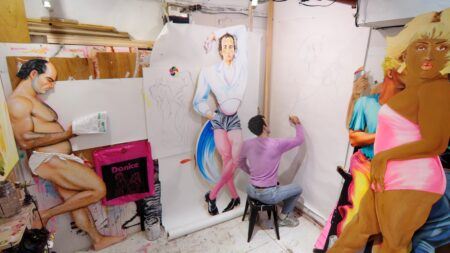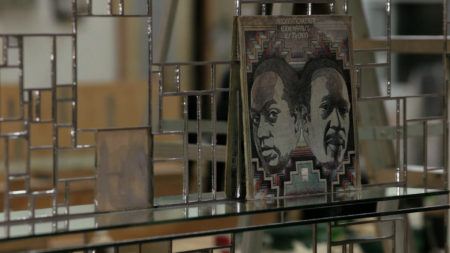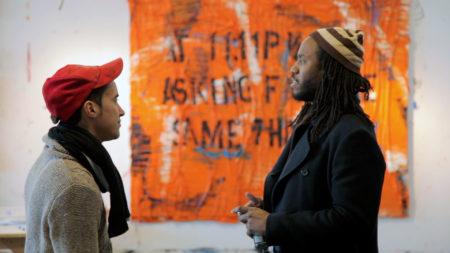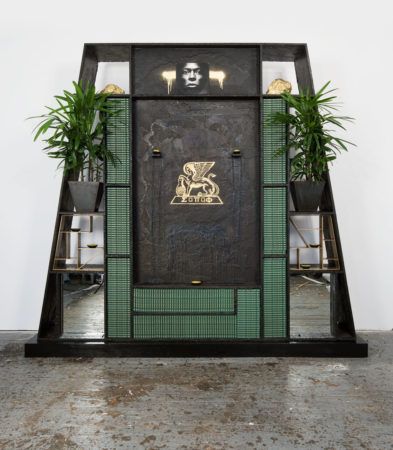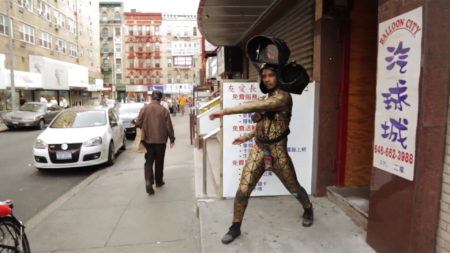Continue playing
(Time remaining: )
Play from beginning
Continue playing "{{ controller.videos[controller.getVideo(controller.currentVideo)].segmentParentTitle}}"
{{controller.videos[controller.getVideo(controller.currentVideo)].title}} has ended.
Rashid Johnson Keeps His Cool
What happens when an artist follows his instincts? In this film, artist Rashid Johnson charts a decade-long aesthetic and professional development from his early portrait photographs to his later conceptually-based sculptures made from glass, wood, and tile. Johnson is “a materialist at heart” and his earliest work—painterly, monochromatic photographs of African-American men made with obsolete 19th-Century techniques—evidence a career-long fascination with materials and processes. The photographs also unexpectedly get him his first gallery show while still an unknown undergraduate student at Columbia College in Chicago. It’s the start of a successful exhibition run, including shows at the prestigious Venice Biennale and the Museum of Contemporary Art Chicago, that continues to this day.
At Hauser & Wirth gallery in New York City, Johnson helps install large-scaled, formally exacting sculptural works made with what have become signature materials like shea butter, black soap and wax, and zebra skin. Though those materials evoke Johnson’s own complicated relationship to African-American identity and culture, the artists says, “My black-ness…[has] a strong effect on how my work is born and around the conversation that inevitably will happen, but I don’t think that it’s really the sum off all what my work is. And I think formally I’m trying to approach art-making in a way that is part of the bigger history of art.”
More information and creditsFeaturing works from the exhibitions 25 Days after October (2010) at Massimo De Carlo, Milan; ILLUMInations (2011) at the 54th Venice Biennale, Italy; RUMBLE (2012) at Hauser & Wirth, New York; and Islands (2014) at David Kordansky Gallery, Los Angeles. Featuring music from the album Jazz Sampler by Kevin MacLeod.
Credits
Art21 New York Close Up Created & Produced by: Wesley Miller & Nick Ravich. Editor: Michelle Chang. Cinematography: Don Edler, Ian Forster, John Marton, Jared Schiller, Andrew David Watson. Sound: Nicholas Lindner & Wesley Miller. Associate Producer: Ian Forster. Production Assistant: Paulina V. Ahlstrom & Maren Miller. Design: CRUX Design & Open. Artwork: Rashid Johnson. Music: Kevin MacLeod. Thanks: Stephanie Andreou, Cristopher Canizares, Maisey Cox, David Kordansky Gallery, Jen Durbin, Alex Ernst, Hauser & Wirth New York, Marc Payot, The 1896 Studio & Stages, Andrea Schwan, & Venice Biennale. An Art21 Workshop Production. © Art21, Inc. 2015. All rights reserved.
Art21 New York Close Up is supported, in part, by The Lambent Foundation; the New York City Department of Cultural Affairs in partnership with the City Council; The Andy Warhol Foundation for the Visual Arts; and by individual contributors.
Closed captionsAvailable in English, German, Romanian, Italian, Japanese, Korean, Chinese, Italian
Through the Art21 Translation Project, multilingual audiences from around the globe can contribute translations, making Art21 films more accessible worldwide.
Interested in showing this film in an exhibition or public screening? To license this video please visit Licensing & Reproduction.
Rashid Johnson was born in 1977 in Chicago, Illinois, and lives and works in New York. Johnson, who got his start as a photographer, works across media—including video, sculpture, painting, and installation—using a wide variety of materials to address issues of African American identity and history. Invested in the artistic practices of both conceptualism and abstraction, Johnson’s installations frequently include shea butter and black soap, materials that were present throughout his childhood and that carry a particular significance within Afrocentric communities.
“My black-ness…[has] a strong effect on how my work is born and around the conversation that inevitably will happen, but I don’t think that it’s really the sum off all what my work is.
And I think formally I’m trying to approach art-making in a way that is part of the bigger history of art.”
Rashid Johnson
Trailer
